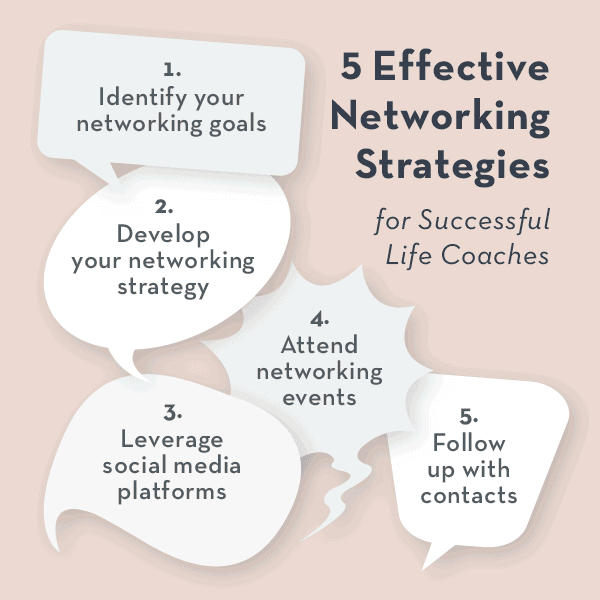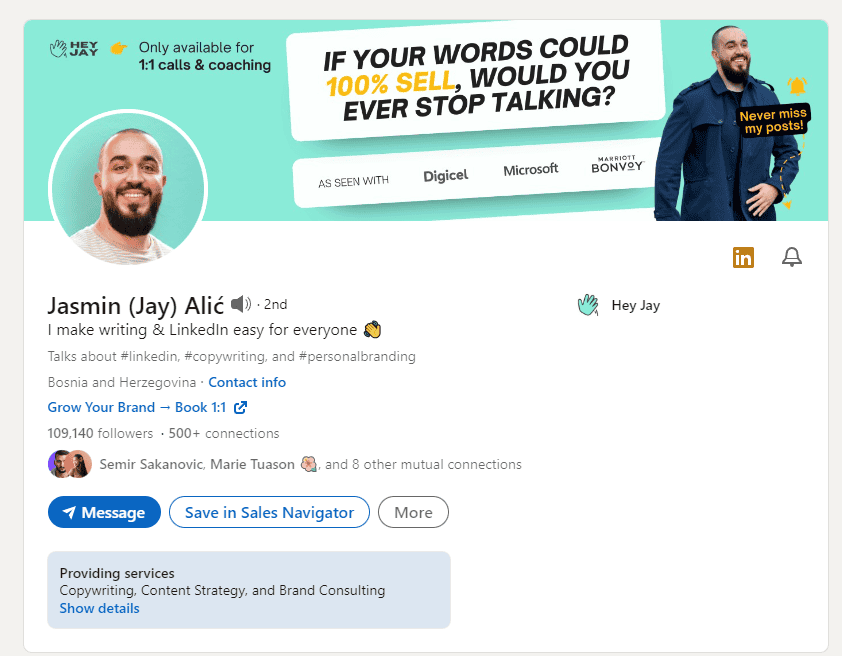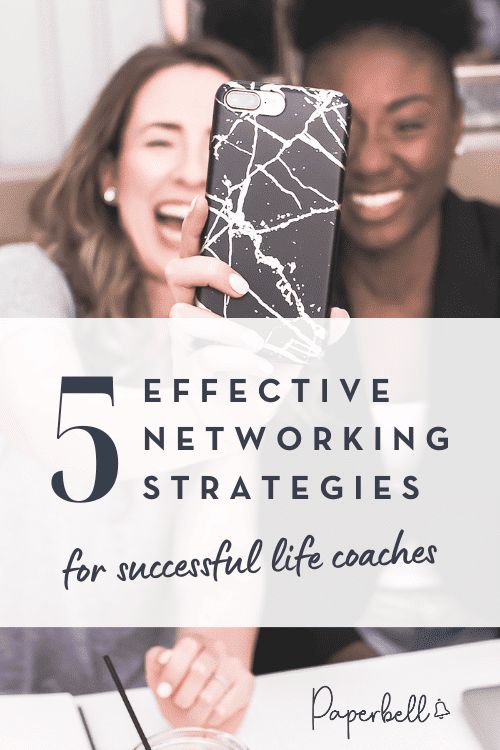Have you ever felt networking was more of an obligation than an opportunity?
Well, you’re not alone. Many people find professional networking challenging.
Despite some of our difficulties, professional networking can be much easier and more beneficial with a solid plan.
But how do you go about implementing networking effectively?
In this post, we’ll explore why networking is crucial for career progression and how to harness the power of strategic networking.
We’ll discuss various networking tips and strategies to make building stronger networks less daunting and more valuable.
Let’s dive into why networking is essential and five effective networking strategies you can try as a coach.
Why is Networking Important?
If you’re a coach, having solid relationships is essential for success. This is where networking comes into play.
Networking isn’t just about boosting your clientele; it’s also about learning from others in the same field and discovering opportunities to work together.
But why exactly is networking so critical? Let’s dive into some key benefits.
Growth Opportunities
Connecting with other coaches can help you discover new ideas and perspectives that will help you grow as a professional.
If you join a life coach network, you might learn about an innovative coaching technique or gain insights into better serving your clients.
New Clients
The more people who know what you do, the higher the chances of referrals coming your way.
A recommendation from someone within a potential client’s network often carries more weight than any advertisement.
Mentorship and Support
Building connections with experienced coaches and other business owners can lead to mentorship opportunities, which are invaluable when navigating the challenges of this profession.
Plus, having a supportive community helps keep your motivation high during tough times.
Effective strategies are needed to fully leverage a life coaching network. Let’s explore these strategies and how to make the most of them.
5 Effective Networking Strategies for Coaches

Networking isn’t just about attending events or collecting business cards. The point is to make genuine connections that will ultimately open doors to new opportunities, collaborations, and clients.
Here are some proven networking strategies that can help you build a reliable network.
1. Identify Your Networking Goals
The first step in any successful strategy is to identify your goals.
What’s your game plan? Are you seeking new clients or aiming to collaborate with other coaches?
Or maybe you’re thirsty for knowledge and want to tap into the latest coaching trends.
Once you know what you want to achieve, you must make a plan and focus your energy on people who can help you achieve it.
For example, if you’re after new clients, it’s better to attend events where they’re likely to hang out instead of spending time with other coaches.
Your networking goals might include the following:
- Finding potential clients
- Forming strategic partnerships with coaches in parallel niches
- Gaining industry knowledge
- Promoting yourself as a coaching expert
Getting more coaching clients requires a different approach than cozying up to fellow coaches or learning from the bigwigs in the field.
But hold up.
Before considering any strategies, ask yourself: What makes you special? How can others benefit from connecting with you? It’s a two-way street, after all. Others will want you in their network just as much as you want them in yours.
2. Develop Your Networking Strategy
The second step to effectively networking as a life coach is developing your unique strategy. A well-thought-out plan will help you decide which events to attend and which social media platforms to communicate on.
Identify the right people and organizations to build relationships with. Your networking strategy should be tailored to your coaching niche, goals, and personal style.
For example, if you’re an executive coach focusing on leadership development, you can network with HR managers or executives in large corporations.
Here’s how you can develop a solid networking strategy:
- Define your target audience: Who can benefit from your services? Think about both potential clients and influencers who can refer clients to you.
- Determine where they hang out: Where do these people spend their time online and offline? Industry events, local meetups, LinkedIn groups, virtual summits? Find them and join the party.
- Create a plan of action: How will you approach them? What value can you offer? Successful networking is about building mutually beneficial relationships.
A carefully crafted strategy ensures that every networking effort is purposeful and aligns with your business objectives.
It helps you avoid wasting time on irrelevant networks and increases your chances of forming meaningful connections that lead to opportunities.
3. Leverage Social Media Platforms
Digital networking strategies, like social media platforms, can be powerful for making connections and engaging with potential customers and partners.
As a life coach, you can contact people interested in your services using these platforms.
Note that social media isn’t just about broadcasting your message; it’s also a dialogue. Make sure you engage with followers by replying promptly to comments and messages.
On LinkedIn, join groups connected to your specialty or set up a group where you can offer helpful advice. Here’s how:
- Create a compelling LinkedIn profile that highlights your coaching skills and experiences.
- Join relevant groups or discussions on LinkedIn where you can showcase your knowledge while learning from others.
- Publish posts regularly about topics related to life coaching. This will help establish you as an expert and increase your visibility among potential clients.
Here’s an example of a perfectly tailored profile from Jasmin Alić:

Why is this profile effective? Let’s walk through it:
- His bio states precisely how he helps his audience.
- The header image serves several purposes: specifies his services, provides social proof, reminds people to follow him, and catches your attention with a hook.
- The link specifies what you’ll get when you book a 1:1 coaching session with him.
The lesson here? Treat your LinkedIn profile as you’d treat a sales page.
Facebook, Instagram, and Threads
Facebook and Instagram offer opportunities for networking through their various communities.
You can use Facebook to join life coaching, self-improvement, and wellness groups. Participate actively by posting questions, providing answers, and sharing resources.
You can also leverage Instagram and Threads to build a community and engage with others. As Threads is getting more popular, many coaches use it to show up as a more authentic and raw version of their Instagram selves.

4. Attend Networking Events
Whether in-person or virtual, networking events are like a treasure trove for meeting like-minded professionals, potential clients, and industry leaders.
Consider hosting your event to showcase your expertise and create brand awareness. Here’s how you can get started:
- Find the right events to attend. Do online research for life coaching conferences, seminars, workshops, or meetups relevant to your niche. Remember, you want events that align with your networking goals.
- Once you’ve found suitable events, prepare yourself. Polish your elevator pitch and update your business cards with your contact info and social media handles. You want to make a killer first impression.
- Now, here’s the secret sauce: active participation. Don’t just be a passive observer; get involved! Engage in conversations, ask smart questions during Q&A sessions, and volunteer whenever possible. Show that you’re committed to learning and growing in the coaching field.
Networking isn’t about aggressively selling yourself. Connect with others by building a relationship grounded in mutual respect and shared goals.
Show genuine interest in others’ work; they’ll be more likely to stay connected with you after the event.
5. Follow Up With Contacts
Meeting new people is one thing but the game is in the follow-up.
Make sure you nurture the relationships you initiate with the people you meet. The key to that is consistency and authenticity. Instead of being pushy or salesy, aim for genuine connection and conversation instead.
For example, I was recently invited to a coffee chat with Mike Gregga, a workflow and business systems consultant. He specified that these calls would be pitch-free.
And guess what? It was!
The call was exactly as advertised: a coffee chat. We exchanged banter, shared tips, and got to know each other better.
As a result, I’m much more likely to go to Mike if I need help with my systems. I’m also more likely to refer people to him if they need help.
Here’s another example of someone incorporating contact nurturing into their business operations.
Every month, ethical cold email coach Bree Weber opens up three spots on her calendar to connect with her contacts. She calls this Bevy and Banter.

When you treat it as a way to connect and have fun, the pressure to “build a network” melts away, allowing you to be yourself.
That’s where genuine relationships are made.
Build Your Coaching Business With Effective Networking Strategies
Networking strategies are essential in growing your business and establishing valuable connections.
You can have a successful coaching business without networking. But it helps to expand your playing field and feel like you’re not in this alone.
It isn’t just about making acquaintances; it’s about forming meaningful connections that benefit both parties.
So take the time and energy to invest in your network and watch as it pays off in the long run.
Are you worried that networking may take up too much of your time? Why not streamline the admin side of your coaching business with Paperbell and reinvest that time to build your network?
With Paperbell, running your coaching business online is faster and easier than ever. Register for a free account today.

Editor’s Note: This post was originally published in August 2023 and has since been updated for accuracy.









